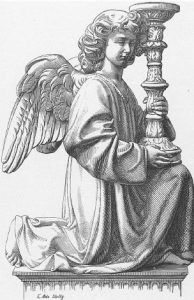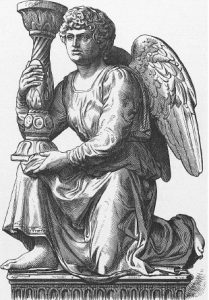Shortly before Piero de’ Medici fled from Florence on the ap proach of the French army (I494), Michelangelo retired to Bologna, and there resided for the greater part of a year in the house of Gianfrancesco Aldovrandi, a refined and cultivated magistrate, who accidentally met hiim at the city gate on his arrival, saved him from the imprisonment or fine with which he was threatened for non-compliance with certain municipal regula tions, and offered him a home. These acts of mercy blessed the giver and the receiver; for while Aldovrandi gained a companion who sympathized in his love for Dante, Petrarch, and Boccaccio, and read aloud to him from their pages with rare expression and intelligence, his guest found this occupation the very best medicine for his depressed spirit, which, since the death of Lorenzo de’ Medici, at whose court he had first learned to appreciate these master minds, had never recovered its tone.
Once. more he felt an appetite for work, and turned to clay and marble, hoping not only to satisfy the imperious instincts of his nature, but to replenish the empty purse with which he had reached Bologna. It was, however, by no means easy for a sculptor to find remunerative work in a city where art patronage was scant, and the efforts of a stranger to obtain employment were certain to be looked upon by native artists as an encroachment upon their privileges. Fortunately for Michelangelo, it happened that at this time the Dominicans were in need of a competent person to make two statuettes of Saints Petronius and Proculus, and a kneeling angel holding a candelabrum. These marbles were needed to complete the monument of St. Domenick, for which Niccola da Bari, an Apulian sculptor long resident at Bologna, had, so far back as the year I464, furnished a design, and had bound himself by contract to sculpture nineteen statuettes, and two kneeling angels for the altar table before it, within the space of thirty months. The monument which rises above the arca, or sarcophagus, sculptured in 1260 by Niccola Pisano and his scholar, Fra Guglielmo Agnelli, was not ready at the appointed time, and although Niccola, called dell’ Arca from it, lived twenty-two years longer, he for some reasoil or other failed to complete it. We might suppose that he had done so, with the exception of the two statuettes and the angel afterwards assigned to Michelangelo, did we not know, from an entry in the archives, that in the year I532 the sum of one hundred scudi was expended “ad perficiendum Arcam S. Domenici.
” Was this money paid to some unknown sculptor for one of the two angels now standing upon the altar table? If so, then neither can be the work of Niccola da Bari, as the other is certainly by Michelangelo, for it must be remembered that, although Niccola contracted to make both, he may have made neither, and can have made but one. The well-known Bolognese art critic and writer, Michelangelo Gualandi, in his I’femorie risgutardanzti le Belle Arti (Serie V. p. 32), does indeed declare that the angel to thle left of the spectator, until lately.

NICCOLA DELL’ ARCA’S Angrl in S. Domenica at Bologna.
Thissupposed to be the work of angelo, cannot be by him; -cause the contract with Niccola bids the supposition; and, secondly,because no one who sees it suade himself that the future of the David and the Moses the author of such a work. these ‘conclusions we cannot agree him; -first, because Niccola ca was a wayward and eccentric son, who would not have scrupled neglect his contract, if he felt clined to work; secondly, because fact that a commission for was given to Michelangelo proves Niccola had not kept his promise; and, thirdly, (in answer to Gualandi’s second objection,) because, although as we have said elsewhere (Raphael and Michelangelo, p. angel in question “has so little viduality and so little power, that, it not known to be by Michelangelo, it would never have been recognized as such,” it is possible that erately adopted a style foreign habit, in order that his work be in harmony with that of decessor.
He had proved his of imitating the quattrocento several years before, when he modelled the Madonna delle Scale, Casa Buonarroti at Florence; and, as if to make up for the self-imposed given full rein to his fiery nature in that. tumultuous and characteristic Centaurs and the Lapiths, preserved in the same interesting collection. residence at Bologna he is known to have studied the bas-reliefs Petronius, by Giacomo della Quercia, of Siena, who has been called his that some signs of Quercia’s influence may be detected in the heavily treated draperies of the angel at St. Domenick, which, until recently, the great Florentine. Until the publication of the first part of Herr Anton Springer’s Raphael no one absolutely disputed the correctness of this attribution, but at author speaks of ” the angel to the right of the spectator, on the so-called altar,” as Michelangelo’s; and adds: “The head, with the short hair and has little of that angelic character which distinguishes the kneeling angel Niccola dell’ Arca, who died at Bologna, March 2d, I494.” In the second Springer has given wood-cuts of the two angels, here reproduced, and in referring 492, he says: “It is only necessary to compare the heads, in order to Michelangelo.” Judged by mere eyesight, without any knowledge of we heartily agree that, as the angel to the right is Michelangelesqu.not at all so, it would be reasonable to suppose that Michelangelo sculp tured the first rather than the last, and we should consider the question settled could it be proved, first, that Niccola dell’ Arca sculptured an angel; secondly, that Michelangelo did not purposely imitate his style, in order to harmonize his own work with the rest of the monument; and, thirdly, could we bei assured that the money spent in I532 to complete the monument of St. Domenick was not in payment for A the very angel which Herr Springer thinks Michelangelo sculptured in 1494.

MICHELANGELO’S Angel in S. Domenico
As matters stand, we think there is still room for doubt, nor do we think that Herr Springer strengthens his po sition by saying, as he does at page 492: “If, however, the angel to the right of the spectator is by Michel angelo, he can never have made the – statue of the youthful St. John at Pisa, belonging to Count Rosselmini Gualandi, which has been identified with the Giovannino made for LorenzoMN di Pierfrancesco de’ Medici in I495. 1 In the course of so few months Michel angelo cannot have so completely changed his style, and, after he had in the angel so fully manifested his individuality, have immediately turned back into the old ruts of the quattrocento.” To this we can only answer that, although we do not believe the San Giovannino to be by angelo -if for no other reason than that we can find no such motive for imitation as in the case of the angel at St. Domenick, -we do believe that Michelangelo was quite of transforming his style at will, as Proteus did his shape. In proof of this power already cited the quattrocento bas-relief at the Casa Buonarroti, and the Michelangelesque of the Centaurs, which followed it. Indeed, were we disposed to go still further back, remind Herr Springer that Michelangelo’s first two works were imitations,-the one of Schongauer, the Temptation of St. Anthony, and the other of the antique, the Faun’s the Uffizi.
CHARLES C. PERKINS.




